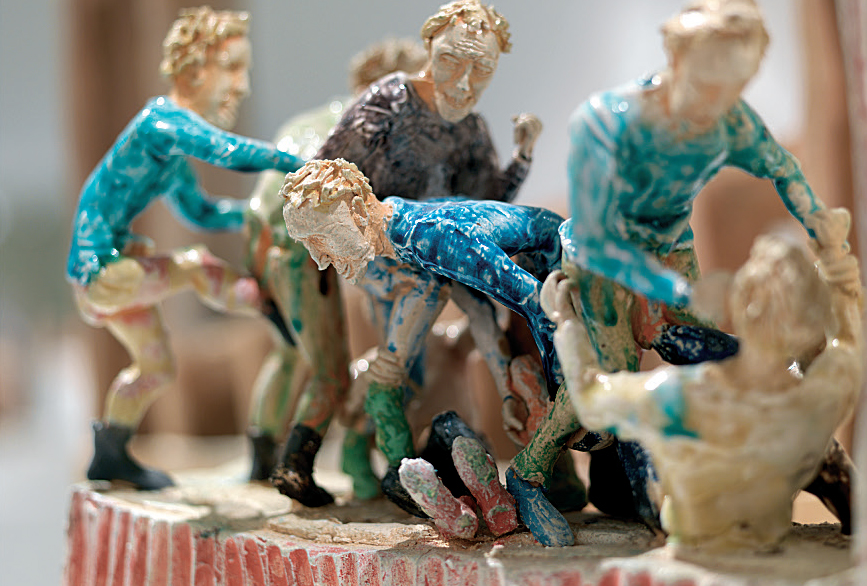Arnie Zimmerman and Tiago Montepegado’s exhibition catalog for Inner City is now available in cfile.library. For access to all of cfile.library begin your free membership trial today.
Inner City: Arnie Zimmerman and Tiago Montepegado
Tannenbaum, Judith
Providence: Museum of Art, Rhode Island School of Design, 2009
46 Pages
Inner City, Arnie Zimmerman and Tiago Montepegado’s collaborative art installation, traveled from Lisbon to the Netherlands, then to Rhode Island School of Design in Providence. The exhibit consisted of glazed stoneware figurines and buildings by ceramicist Zimmerman and a less-apparent, but indispensable blueprint by architect Montepegado. Arnie’s figures and structures–thronging the space that Montepegado mapped–are playing every conceivable mundanity: construction worker, loner, prisoner, bench-sitter, brawler, and more. And the structures comprise bridges, tenements, skyscrapers, etc. With more than 200 pieces, Zimmerman and Montepegado’s exhibition at RISD attempts to tell a story about the architecture and the people of New York City, with reference to the past, present, and future of the city.
Zimmerman, whose vision comes through a little bit clearer in the catalog, broke into the ceramic art world with large carved vessels. But he now focuses on figurines (something he never though he would do) with an aesthetic that feels thrown-together and handmade, huge but not so technical: miniature humans made by human hands.
“The way I work with clay [figurines] would have been anathema to the artists of the 18th century trying to please their royal patrons. I do like firing accidents and imperfections that show the hand in the process of the craft. It has always been a characteristic of my work…. This so-called coarseness heightens the character of the types of humanity in Inner City. My godly hands are making this diminutive humanity. They are workers, low-lifes–generic people.”
There is no mistaking the social reverberations of Inner City. These figurines delineate what curator Judith Tannenbaum calls “everyman”- or regular dude, a term that was often assigned to the work of Hieronymus Bosch and Peter the Elder who painted throngs of regular people in a city center, mocking the aristocracy. And it’s true – in this exhibition, Zimmerman turns our eyes to people and structures on the “periphery” of the least periphery place in the world–NYC. But Zimmerman suggests that in the biggest, most “important” places perhaps the most people are left behind by society.
“I grew up in the 1950s and 60s and the influence of that time cannot be underestimated for me. I’m from well-educated middle class privilege, but I have the gnawing feeling it could all disappear in an instant…. corporate America stealing our rights as citizens in a democracy.”
Zimmerman wanted to collaborate with an architect because he saw the profession ultimately as a group of installation artists, and living in New York City he is aware just how much the physical constructions that we live in and work around influence us.
“They work with the space that we physically exist in, and through a rigorous design/thought process or their practice they manipulate material, think about the human experience and the human condition, and contribute a great deal to the success or failure of the built environment in which we live.”
Zimmerman was six blocks from the World Trade Center when two planes hit two buildings.
“The events of 9/11 have had a huge impact on my work…. Terror, random death, massive destruction, and a profound sense of impermanence and fragility are what entered my work after 9/11. I turned to one of the most undesirable aspects of ceramics. Its physical fragility.”
Living and working in NYC, witnessing 9/11 and the rapid gentrification of Brooklyn, watching people live, exist inside and outside of buildings simultaneously, constantly, and all at once himself being a cog in the machine, has had a great impact on Zimmerman, and was obviously the greatest inspiration for Inner City.







Add your valued opinion to this post.